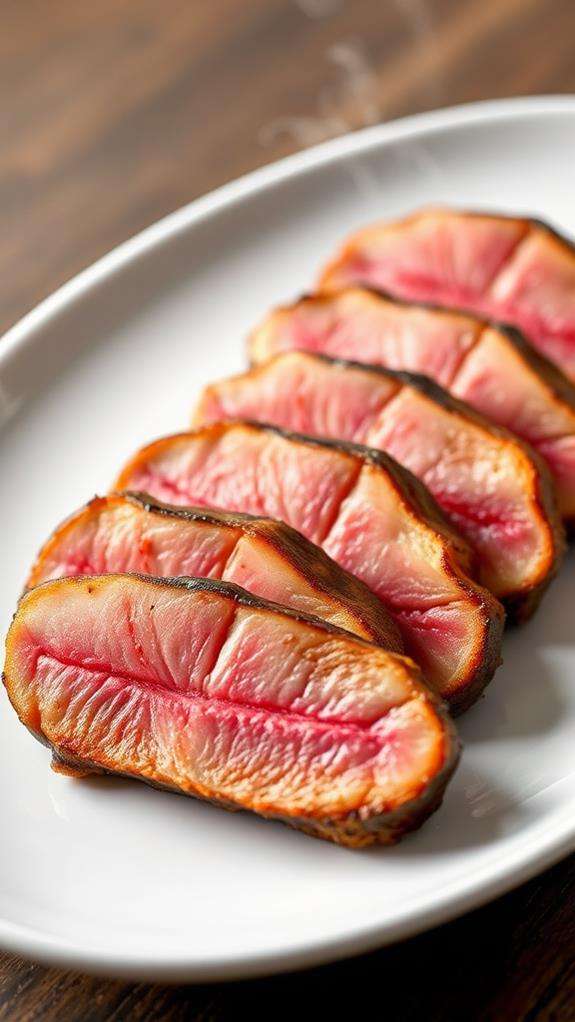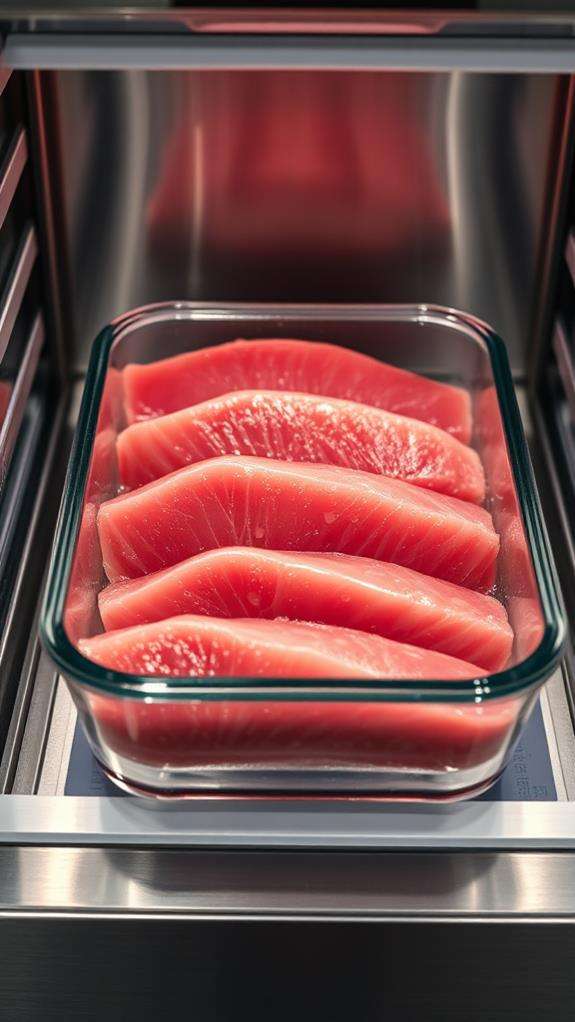How to Reheat Ahi Tuna
To reheat ahi tuna properly, let it rest at room temperature for 15-20 minutes first. You'll have two effective options: stovetop searing or oven warming. For stovetop, heat a skillet to medium-high and sear each side for 30-60 seconds. For oven warming, wrap the tuna in foil and heat at 275°F for 10-15 minutes. Avoid microwaving, as it can dry out the fish and create hot spots. For best results, consider brushing the tuna with a light coating of oil or marinade before reheating to maintain moisture. The key lies in gentle reheating while preserving the tuna's delicate texture and flavor – and there's much more to explore about perfecting this technique.
This post may contain affiliate links. If you make a purchase through these links, I may earn a commission at no additional cost to you. Additionally, portions of this post may be generated using artificial intelligence (AI) technology. While we strive for accuracy, please be aware that AI-generated content may not always be perfect and should be fact-checked when necessary.
The Spatula Scoops
- Let ahi tuna rest at room temperature for 15-20 minutes before reheating to ensure even warming throughout the fish.
- For stovetop reheating, sear each side in a medium-high heat skillet for 30-60 seconds to maintain texture.
- Use the oven method by wrapping tuna in foil and heating at 275°F for 10-15 minutes for gentle, moisture-retaining warming.
- Avoid microwaving as it can create hot spots and dry out the fish.
- Enhance flavor by adding a fresh marinade of soy sauce, ginger, and sesame oil before reheating.
Essential Room Temperature Preparation

Before reheating your leftover ahi tuna, let it rest at room temperature for 15-20 minutes. This vital step helps enhance flavor and guarantees you'll achieve better results when warming up your fish. You'll find that bringing the tuna to room temperature creates a more uniform heating process, which is crucial for maintaining its delicate texture.
When you take your ahi tuna directly from the refrigerator to heat it, you're likely to end up with overcooked edges and a cold center. By allowing the fish to rest, you're giving it time to reach a consistent temperature throughout the entire piece. This temperature equilibrium is key to preventing the common problem of uneven heating that often ruins leftover seafood. You'll notice that the overall eating experience improves greatly when you follow this simple but important preparation step.
Remember that timing is everything when it comes to the resting period. Don't leave your ahi tuna out for longer than the recommended 15-20 minutes, as this guarantees both food safety and ideal results. The tender texture you enjoyed during your first serving can be preserved when you take this essential preparatory measure.
Best Reheating Methods

You'll find two primary methods for reheating ahi tuna: stovetop searing and oven warming, each offering distinct advantages for preserving the fish's quality. For stovetop searing, heat your skillet to medium-high and add oil, then quickly sear each side for 30-60 seconds to maintain the tuna's original texture and moisture. When using the oven method, wrap your tuna in foil and heat at 275°F for 10-15 minutes, which provides a gentler, more controlled warming process that helps prevent the fish from drying out.
Stovetop Versus Oven Methods
Reheating ahi tuna presents two main methods: stovetop and oven, each offering distinct advantages for preserving the fish's quality. On your stovetop, you'll want to heat oil in a skillet over medium heat, searing the tuna for 30-60 seconds per side to achieve that desirable crust while maintaining the fish's tender interior. This method gives you better control over the final texture and enhances flavor through quick surface browning.
If you're opting for the oven method, you'll need to preheat to 275°F and wrap your ahi tuna in foil. This gentler approach takes 10-15 minutes but provides even heat distribution and helps retain moisture throughout the reheating process. While it won't create the same seared exterior as the stovetop method, it's less likely to dry out your fish.
For ideal results, consider your preferences and timing. If you enjoy a slightly crispy exterior and want a quick reheat, the stovetop method is your best choice. However, if you're concerned about maintaining moisture and don't mind waiting longer, the oven method will serve you well.
Quick-Sear Temperature Guidelines
Getting the temperature right is vital when quick-searing ahi tuna for reheating. Before you begin, let your tuna rest at room temperature for about 20 minutes, as this step prevents uneven cooking and helps maintain the fish's delicate texture. When you're ready to start, heat your skillet over medium heat, adding a thin layer of oil or butter for ideal browning.
Once your pan is properly heated, you'll want to quick-sear each side of your ahi tuna for no more than one minute per side. This brief cooking time guarantees you don't overcook the fish while restoring its exterior texture. If you're opting for oven reheating instead, wrap your tuna in foil and set your oven to 275°F. The foil method requires 10-15 minutes of gentle heating to preserve moisture and flavor. Whatever method you choose, avoid using the microwave, as it'll create hot spots and dry out your fish. Remember, the goal is to warm your ahi tuna while maintaining its original quality, so keeping a close eye on temperature and timing is essential for the best results.
Maintaining Flavor While Reheating

To maintain the rich flavor of your ahi tuna while reheating, you'll want to start with a quick sear on medium heat, limiting the cooking time to just one minute per side. For enhanced taste and moisture retention, you can prepare a marinade using ginger, shallots, soy sauce, and sesame oil before reheating. If you're looking to add extra depth to your reheated tuna, consider applying a sesame crust during the reheating process, which creates a flavorful exterior while protecting the fish's natural taste.
Quick Sear Techniques
When it comes to maintaining the delicate flavor of leftover ahi tuna, a quick sear delivers exceptional results. Before you begin reheating ahi tuna, let it rest at room temperature for approximately 20 minutes, which guarantees even heating and prevents the fish from becoming tough or dry during the searing process.
To achieve the perfect sear, start by heating a non-stick skillet over medium heat. Add a small amount of oil, which will help create a flavorful crust while keeping the tuna's texture tender and juicy. Once your pan is properly heated, place your tuna steak in the skillet and sear each side for no more than one minute. This quick cooking method helps maintain the fish's original quality without overcooking it.
Remember that timing is essential when searing ahi tuna. You'll want to watch carefully as the color changes along the edges of the fish, indicating it's warming through. The goal is to heat the tuna just enough to enjoy while preserving its delicate texture and rich flavor profile, avoiding any additional cooking that might compromise its quality.
Marinade During Reheating
Maintaining flavor throughout the reheating process starts with a well-crafted marinade mixture. You'll want to combine ginger, shallots, soy sauce, and sesame oil to create a light yet flavorful base that'll help preserve your ahi tuna's natural taste and texture.
Before you begin reheating, let your marinated tuna rest at room temperature for about 20 minutes. This simple step guarantees even heating and better flavor absorption. When you're ready to reheat, preheat your skillet and add a splash of the marinade to enhance moisture retention. You'll notice that the additional liquid helps prevent the fish from becoming dry or bland during the reheating process.
To maximize flavor, you can apply a fresh coat of marinade after reheating. This technique works particularly well because the warm tuna will readily absorb the new flavors, giving you a more vibrant final result. Remember to keep the marinade light – you don't want to overpower the delicate taste of the ahi tuna. This balanced approach helps maintain the fish's natural texture while guaranteeing each bite remains moist and flavorful.
Serving Suggestions After Reheating

Serving reheated ahi tuna opens up a world of delicious possibilities for your meal. You'll find that this versatile fish can be transformed into various dishes that maximize its rich flavor and tender texture. For a light and invigorating option, place your reheated ahi tuna over sushi rice or mixed greens to create a stunning poke bowl, topped with fresh vegetables and a sesame vinaigrette.
If you're looking for a more substantial presentation, serve your tuna on a bed of fragrant jasmine rice, garnished with fresh herbs and a bright citrus accent. You can also transform your leftover ahi tuna into a gourmet tuna salad by flaking it and mixing it with mayonnaise, capers, and crisp diced celery – perfect for sophisticated sandwiches or wraps. For a creative twist, consider incorporating your reheated ahi tuna into flavorful tacos, topped with crunchy cabbage, fresh salsa, and creamy avocado. Don't forget to enhance any of these serving options with complementary sauces, such as a soy-ginger glaze, which will bring out the best in your reheated fish.
Safe Storage Guidelines

Proper storage of your ahi tuna will guarantee you can enjoy those delicious serving options safely and with the best possible flavor. To maintain ideal freshness, you'll need to follow specific safe storage guidelines that prevent bacterial growth and potential foodborne illnesses.
Start by storing your leftover ahi tuna in an airtight container, which creates a protective barrier against air and moisture that could compromise its quality. You'll want to refrigerate the fish within two hours of cooking – this timeframe is vital for food safety. While you're at it, don't forget to label your container with the date you cooked the tuna, as this will help you track storage time effectively. When it comes to consumption, you should plan to eat your refrigerated ahi tuna within 1-2 days for the best taste and safety. Remember that leaving your tuna at room temperature for extended periods creates an environment where harmful bacteria can multiply rapidly. If you're not sure how long the fish has been stored, it's better to err on the side of caution and discard it rather than risk getting sick.
Creative Leftover Tuna Ideas

With leftover ahi tuna, you'll discover endless possibilities for creating delicious new meals that go beyond simple reheating. Transform your tuna into various dishes that'll make your leftovers taste like an entirely new creation.
- Create a revitalizing mixed green salad by flaking your leftover ahi tuna and combining it with crisp cucumbers, juicy tomatoes, and a light vinaigrette for a healthy, satisfying meal
- Make a restaurant-style poke bowl by cubing your tuna and serving it over sushi rice with fresh radishes, creamy avocado, and a drizzle of soy sauce
- Turn your tuna into vibrant tacos by filling warm tortillas with flaked fish, zesty cabbage slaw, and tropical mango salsa
- Prepare a classic Nicoise salad using your leftover tuna as the centerpiece, surrounded by tender green beans, potatoes, and briny olives
For a quick meal solution, you can't go wrong with a simple yet satisfying sandwich. Layer your flaked ahi tuna on toasted bread with creamy avocado, crisp lettuce, and ripe tomatoes. These versatile options guarantee your leftover tuna won't go to waste while providing nutritious and flavorful meals.
Frequently Asked Questions
Can You Eat Ahi Tuna the Next Day?
Yes, you can safely eat ahi tuna the next day if you've stored it properly in an airtight container in your refrigerator. For the best quality and safety, you'll want to consume your leftover tuna within 1-2 days. Before eating, make sure to check for any off-putting odors or texture changes. You can enjoy it cold in salads, or if you prefer it warm, reheat it to 145°F while being careful not to overcook it.
Can You Reheat Tuna After It's Been Cooked?
Yes, you can safely reheat cooked tuna, but you'll need to follow some key rules to maintain its quality. Store it in an airtight container in your fridge and reheat it within 24 hours of cooking. Let it sit at room temperature for 20 minutes before reheating. Use a skillet on medium heat for about a minute per side, and don't microwave it as this can dry out your tuna and create uneven heating.
Can You Cook Leftover Ahi Tuna?
Better late than never when it comes to enjoying your leftover ahi tuna! You can definitely cook leftover ahi tuna within 24 hours of initial preparation. First, let it sit at room temperature for 20 minutes. Then, you'll want to quickly sear it on your stovetop for about one minute per side. You'll maintain the best flavor and texture by using an airtight container for storage and reheating gently to avoid drying it out.
Can I Eat Tuna the Next Day?
Yes, you can safely eat tuna the next day if you've stored it properly. Make certain you've refrigerated it within two hours of cooking to prevent bacterial growth. You'll want to consume leftover tuna within 1-2 days for the best quality. When reheating, warm it gently until it reaches 145°F (63°C) to guarantee food safety. However, if you've left it at room temperature for over two hours, it's best to discard it.





